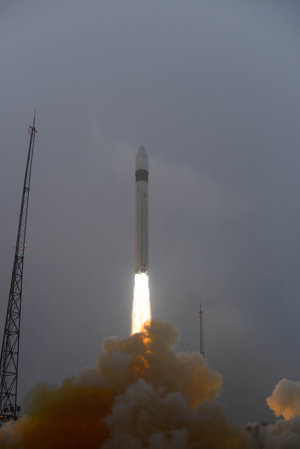Preparing to launch Swarm
With the launch of ESA’s Swarm trio set for 14 November, the first satellite has arrived safely at the Plesetsk Cosmodrome in Russia. This new mission will unravel one of the most mysterious aspects of our planet: the magnetic field.
The arrival marks the beginning of the ‘launch campaign’, which includes an intensive period of tests to make sure that the satellites are fit for launch after their journey from Germany to Russia.
The campaign also includes the careful task of fuelling the satellites and attaching them to the rocket that will deliver them into orbit.
The remaining two satellites will arrive in the next couple of days, the second later today and the third at the weekend.


Access the video
All three will be launched together on a single Rockot.
This first satellite has already been unloaded and taken by lorry to the integration facility, the ‘MIK’.
Swarm is the next in the series of Earth Explorer missions and ESA’s first constellation to advance our understanding of how Earth works.
The three satellites, developed for ESA by a consortium led by EADS Astrium GmbH, have a rather unusual shape – trapezoidal with a boom 9 m long that opens once in orbit.
This long boom means that the sensors at the tip avoid any magnetic interference from the rest of the satellite. Magnetic cleanliness is paramount for the mission.
Harnessing European and Canadian technological excellence, the three identical satellites will untangle and measure very precisely the different magnetic signals from Earth’s core, mantle, crust and oceans, as well as its ionosphere and magnetosphere.

The measurements from this state-of-the-art mission will yield new insights into many natural processes, from those occurring deep inside the planet to weather in space caused by solar activity.
In turn, this information will yield a better understanding of why our magnetic field is weakening.
Preparations for the launch of the Swarm mission from Plesetsk can be followed on ESA's launch campaign blog.














 Germany
Germany
 Austria
Austria
 Belgium
Belgium
 Denmark
Denmark
 Spain
Spain
 Estonia
Estonia
 Finland
Finland
 France
France
 Greece
Greece
 Hungary
Hungary
 Ireland
Ireland
 Italy
Italy
 Luxembourg
Luxembourg
 Norway
Norway
 The Netherlands
The Netherlands
 Poland
Poland
 Portugal
Portugal
 Czechia
Czechia
 Romania
Romania
 United Kingdom
United Kingdom
 Slovenia
Slovenia
 Sweden
Sweden
 Switzerland
Switzerland



























